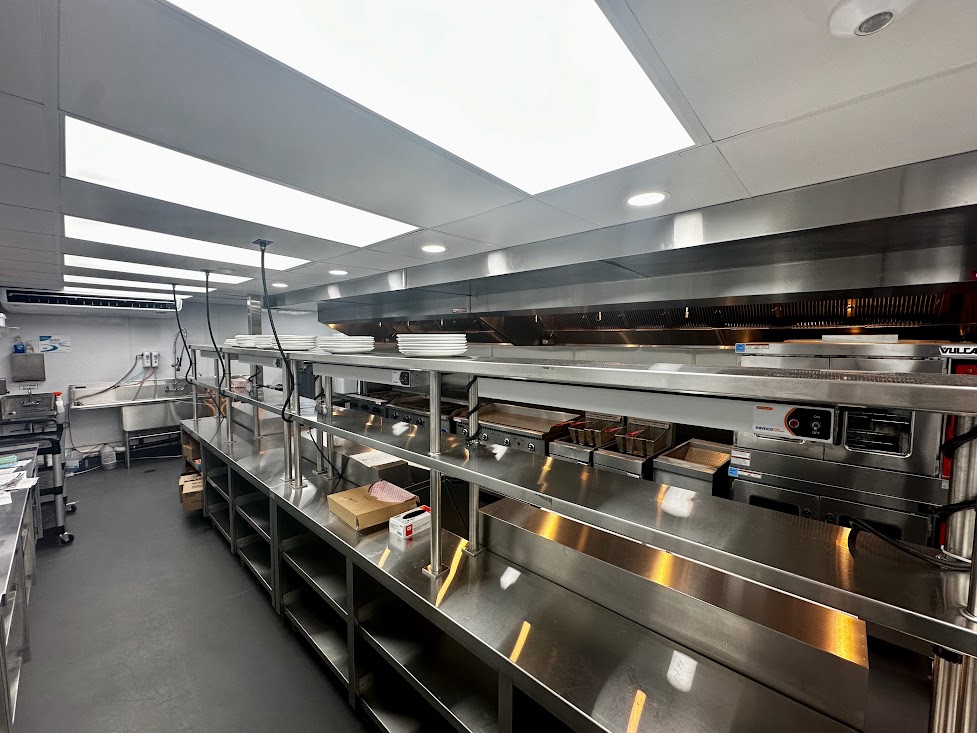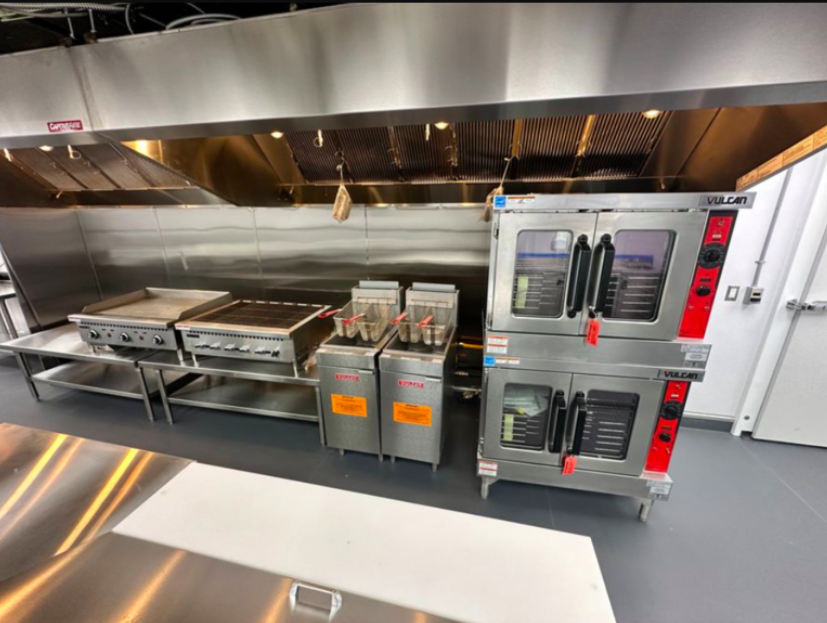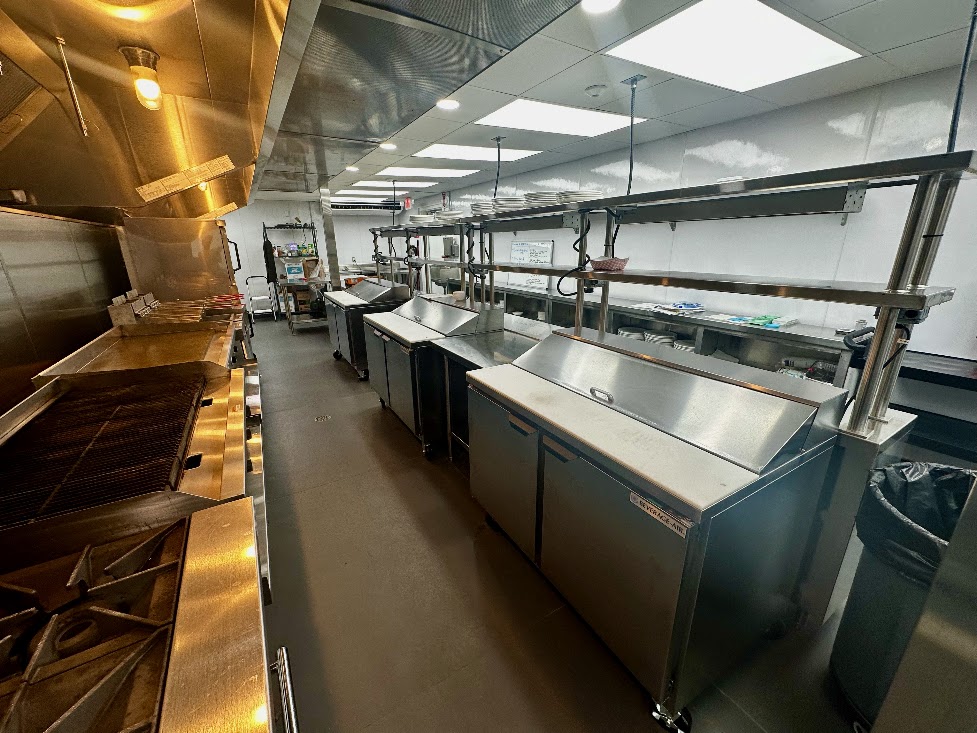Designing a hotel kitchen goes far beyond installing stainless steel appliances. It’s a strategic investment that influences guest satisfaction, staff productivity, food safety, and your long-term profitability. Whether your hotel serves banquets, buffets, room service, or fine dining, the kitchen must be flexible, efficient, and capable of handling high-volume operations with precision.
Multifunctional appliances can save up to 30% of kitchen space, cut labor time, and boost energy efficiency. This underscores how thoughtful design and advanced equipment directly improve efficiency and guest experience.
In this guide, we’ll walk you through the essential principles of hotel kitchen design: including zoning, layout planning, equipment selection, code compliance, ergonomic efficiency, and the advantages of prefabricated modular kitchens from ContekPro.
Whether it’s a quick breakfast before a conference or a gourmet dinner in the restaurant, guests expect fast, consistent, high-quality meals. Poor kitchen design causes delays, increases food waste, and disrupts service flow - ultimately harming guest satisfaction. In contrast, a well-planned kitchen transforms hospitality into a seamless, high-performance operation.
Smart kitchen layouts directly improve operational outcomes. Optimized kitchens can increase service speed by up to 13% and boost guest satisfaction by 17%. Efficient workflows reduce energy usage, cut labor costs, and support happier, more productive teams. For hotel groups managing multiple properties, these improvements amplify returns across locations.
Design is central to maintaining health and safety. Layout choices, from prep areas and ventilation to sanitation zones, play a key role in meeting standards from the FDA, OSHA, and local health departments. Kitchens designed with hygiene, material flow, and air circulation in mind minimize contamination risks and support a safe working environment.
A well-designed kitchen also enhances employee satisfaction and performance. A study on staff at Ritz-Carlton properties found that ergonomic layouts led to higher morale and better productivity, while poor designs resulted in fatigue and operational slowdowns.
Kitchen visibility can also impact service quality. When cooks could see guests during meal preparation, service was faster, and customer satisfaction rose, according to hospitality design research. These improvements highlight how thoughtful spatial planning benefits both staff and guests - bridging front and back of house seamlessly.
Whether your hotel accommodates business travelers, weekend vacationers, or leisure-seeking families, your kitchen must be prepared to handle high-volume service while maintaining consistency and quality with every meal.
And it all begins with a thoughtful, well-planned kitchen layout.
During the early stages of design, it's essential to consult with your executive chef and key food and beverage (F&B) stakeholders. Their firsthand knowledge of operations and menu execution will help you align kitchen design with real-world needs. Start by asking questions like:
These insights provide a foundation for your kitchen’s design, ensuring that every square foot supports productivity, efficiency, and service excellence.

Smart hotel kitchen design balances space, workflow, safety, and adaptability. Whether you're serving business travelers, vacationers, or large events, your kitchen must support high-volume service while remaining efficient and compliant. Here's how to do it right:
Use the industry rule of thumb: allocate 5 square feet of kitchen space per dining seat. For example, a 200-seat restaurant requires at least 1,000 sq ft of kitchen space.
Key space considerations:
Note: Improperly sized kitchens often lead to workflow bottlenecks, staff injuries, and increased operational costs.
Organize the kitchen into functional zones to reduce movement, prevent cross-contamination, and boost efficiency:
Use a linear “flow-through” layout, where ingredients move from delivery to service in a single direction - minimizing backtracking, traffic collisions, and food safety risks.
Tip: Separate raw and ready-to-eat prep zones using color-coded stations and utensils to ensure hygiene.
%20(1).jpg)
The classic kitchen work triangle (sink, cooktop, and refrigerator) should form a perimeter of no more than 26 feet, with each leg between 4–9 feet. This layout minimizes unnecessary steps and physical strain. OSHA’s kitchen ergonomics guidelines stress that thoughtful design significantly reduces workplace injuries.
Tip: Apply this ergonomic principle at both the kitchen level and within individual stations (e.g., pastry, cold prep, hot line) for maximum comfort and efficiency.
Choose versatile, energy-efficient appliances that support high output:
Tip: Look for ENERGY STAR certified units to cut energy usage by up to 30%.
Install:
Note: Sanitation zones should be isolated from prep and cooking areas to maintain food safety. According to the FDA and OSHA, proper zone separation is critical to avoiding contamination and ensuring employee safety.
Plan for:
Tip: Place the delivery dock and storage areas away from food prep lines to minimize contamination risks.

Design your kitchen to evolve with your menu and team:
Tip: Flexible layouts streamline training and reduce downtime during operational changes.
Commercial kitchens consume massive energy: 6–35% of total usage in full-service restaurants. Idle fryers are especially wasteful, often consuming energy 75% of the time without cooking.
Optimize performance with:

Designate a dedicated receiving area and separate from prep or cooking stations. This protects workflow and prevents ingredient cross-contamination.
Storage should be organized for:
Kitchens can exceed 106°F (41.2°C) during peak operations. High heat reduces worker performance and can lead to health risks.
Install:
One foodborne illness incident can cost a hotel between $25,000 and $75,000, according to the NRA Education Foundation. Avoid liability by:
Tip: Conduct regular audits and staff training on HACCP, cross-contamination prevention, and temperature control.
.jpeg)
Modular commercial kitchens offer hotels a faster, smarter, and less disruptive alternative to traditional construction. Built off-site and delivered fully equipped, they’re ideal for renovations, expansions, or seasonal capacity boosts - getting your kitchen up and running with minimal downtime.
Modular kitchens can be deployed up to 50% faster than traditional construction methods. Because units are fabricated and assembled off-site, hotels benefit from better schedule certainty and fewer weather-related or logistical delays. This makes them ideal for meeting temporary surges in demand, whether during peak travel seasons, large conferences, or destination weddings.
From both a short and long-term perspective, modular kitchens offer considerable cost savings. Hotels can expect up to 20% savings compared to conventional construction. These kitchens also benefit from favorable depreciation schedules over a seven-year period, making them an attractive investment from a tax perspective. Additionally, their high resale value further enhances return on investment.
Hotels looking to avoid the complications of coordinating multiple contractors and weeks of on-site disruption will find modular kitchens refreshingly simple. Installation requires fewer contractors, less supervision, and minimal impact on daily operations. Once delivered, the units can be quickly connected and put into use, often within days.
Sustainability is another major advantage of modular kitchens. Their off-site construction process reduces carbon emissions and generates up to 70% less construction waste compared to traditional methods. Components are also designed for reuse or recycling, allowing hotels to meet sustainability goals without sacrificing performance or quality.

While modular kitchens offer significant operational benefits, not all providers are equipped to meet the demands of hospitality. ContekPro specializes in modular kitchens designed specifically for hotels and resorts: environments where high volume, service consistency, and guest satisfaction are non-negotiable.
Every ContekPro kitchen is tailored to match your hotel’s specific needs: whether you're running a banquet hall, rooftop bar, buffet, or 24/7 room service operation. We align the layout with your menu, staffing model, and service volume to ensure smooth workflows and fast-paced production.
We prioritize the flow of movement. Each station is designed with ergonomics in mind to reduce staff fatigue and boost productivity, especially critical in high-volume kitchens where every step counts.
All ContekPro units are delivered with pre-installed HVAC, fire suppression, electrical, and plumbing systems. This turnkey approach drastically shortens installation time, reduces coordination with outside contractors, and ensures consistent code compliance across jurisdictions.
.jpeg)
Our kitchens are constructed with stainless steel surfaces, coved flooring, and corrosion-resistant materials which ensures long-term durability, hygiene, and compliance with health regulations, even under intense daily use.
In hotel properties where space is often limited, we incorporate built-in storage and smart workflow zoning. This allows you to maximize every inch, which is ideal for compact kitchens in boutique hotels or space-saving solutions in urban properties.
Because our modular units are prefabricated and pre-equipped, on-site installation is quick and clean: limiting noise, dust, and disruption to your guests during renovations or expansions.
With our digital design tools, you can walk through your kitchen virtually before it's built. This allows hotel GMs, chefs, and operations teams to provide input early, eliminating surprises and ensuring your kitchen is both functional and aligned with your brand.

In hospitality, time is money and your kitchen is the engine that drives guest satisfaction and profitability. ContekPro modular kitchens combine speed, durability, and design precision to help hotels operate smarter. From luxury resorts to urban business hotels, our solutions support long-term success and short-term agility.
Explore ContekPro’s prefab hotel kitchen solutions or connect with an expert today.
Effective hotel kitchen design focuses on space planning, workflow zoning, ergonomics, equipment selection, and compliance with safety standards. A well-designed kitchen supports high-volume service, reduces staff fatigue, and enhances guest satisfaction.
Modular kitchens provide rapid deployment, minimal installation disruption, and consistent build quality, which is ideal for hotel renovations, event kitchens, or new builds. With pre-installed utilities and code-compliant finishes, they’re a turnkey solution for high-performance hospitality environments.
Zoning separates key functions (receiving, prep, cooking, plating, and sanitation) to prevent cross-contamination and improve efficiency. Clear zones support staff workflow, food safety, and faster service during peak hours.